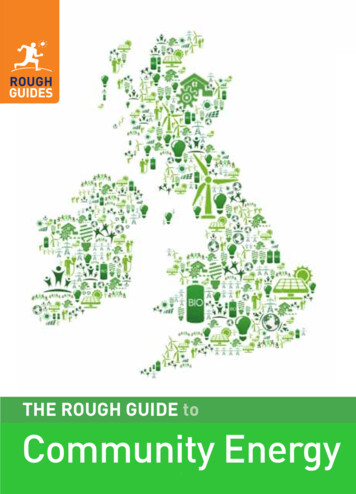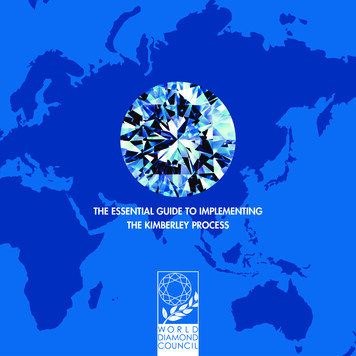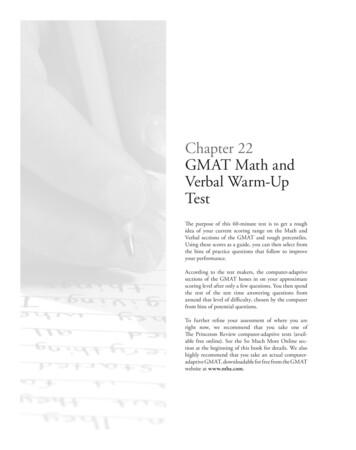
Transcription
UGH GUIDE tommunityTHE ROUGH GUIDE toEnergyCommunity Energy1
THE ROUGH GUIDE toCommunityenergyDuncan Clark &Malachi Chadwick
Credits & publishing informationText: Duncan Clark & Malachi ChadwickDesign: Duncan ClarkContentsThis volume first published May 2011 by Rough Guides Ltd,80 Strand, London WC2R 0RL Duncan ClarkSome of the text in this book is excerpted fromThe Rough Guide to Green Living by Duncan ClarkThe publishers and author have done their best to ensure theaccuracy and currency of all information in The Rough Guide toCommunity Energy; however, they can accept no responsibility forany loss or inconvenience sustained by any reader as a result of itsinformation or advice.No part of this book may be reproduced in any form withoutpermission from the publisher except for the quotation of briefpassages in reviews.Foreword 51. Community energy 7Why take action on energy? 8Why deal with energy at the community level? 102. Energy in the UK 15The energy mix 15The energy industry 18ISBN: 978-1-40538-652-43. Getting together 24Starting a group 254. Energy saving, home by home 37Heating & hot water 42Lighting & appliances 513
5. Community generation: renewables 55Renewable electricity systems 55Renewable heat systems 66CHP 766. Making it happen 77Feasibility study 77Fundraising 78Design 86Forewordby Richard Gillies of M&SWelcome to your Rough Guide to Community Energy! AtM&S, we believe sustainability makes business sense. Afterlaunching Plan A – our five-year, hundred-point eco plan – inJanuary 2007, we saw how much we were saving by beingenergy efficient and using renewable energy in our stores.We knew people across the UK were doing the same, so we launchedM&S Energy, an energy tariff designed to reward households for reducing energy consumption. As well as electricity and gas, we now offerinsulation and solar energy services and it’s great to see how manyhouseholds are taking action.We want to go even further, though. By coming together at a community level, huge numbers of UK households could save money whilesecuring energy supplies and reducing carbon emissions. This isn’t just awin-win situation it’s a win-win-win!We experienced first hand just what an impact community energygroups can have when we worked with En10ergy (see p.41) andHaringey Council to install solar panels on the roof of our Muswell Hillstore. Now we want to make it easier for every community energy groupto get what they need. And who better than Rough Guides to combineall the information and advice in one place?We hope you find this book useful and that it helps you and yourcommunity progress on the low-carbon journey. We’d love to hear aboutyour experiences.Approval 88Construction 93Maintenance 947. Resources 95Richard GilliesDirector of Plan A, CSR and Sustainable Business, M&S45
1CommunityenergyWhat and why?Climate change, rising energy prices, economic austerity,dwindling social cohesion – the world faces a number of challenges that can often seem depressing and intractable. Scratchthe surface, however, and there are plenty of seeds of hope.Across the UK and wider world, people are coming togetherwith their neighbours and showing that, with a bit of dedication and community spirit, it’s possible for ordinary people tomake real progress on a whole range of big issues.There are countless types of community projects, of course, but perhapsthe most exciting at the moment are those focusing on energy – bothsaving it and generating it. The beauty of these projects is that they canhelp deal with so many problems at once, making a difference at thelocal and global levels simultaneously. This book is designed not justto explain what community energy projects are and to help readersset one up, but also to celebrate and showcase some of the pioneeringschemes that have been launched so far. These projects should bea source of inspiration for anyone interested in getting involved intackling climate change or building communities – and they come witha wealth of insights into what does and doesn’t work.6Pupils from Currie High School (see p.68)watch their new wind turbine being installedPhoto courtesy of Curie High School7
community energyWhy take action on energy?Climate change and energy securityEnergy is in the spotlight more than ever before. That’s because the waywe generate and consume it has become central to a host of environmental and social issues – including climate change, energy securityand fuel poverty. Let’s look briefly at each of these.Climate changeAt present, most of our energy comes from oil, gas and coal. It’s easyto understand why: these fossil fuels are packed full of energy and wehave centuries of experience extracting and using them. Unfortunately,there is now overwhelming scientific evidence that the burning of fossilfuels is warming the planet. Largely as a result of oil, gas and coal use,humans now add more than thirty billion tonnes of carbon dioxide orCO₂ to the air each year – more than four tonnes per person. All thatgas goes into the Earth’s atmosphere, which is surprisingly shallow: asthin as a sheet of paper wrapped around a soccer ball.The scientific evidence points to a rise of more than 0.7 C over thelast century. Indeed, the first six years of the twenty-first century, alongwith 1998, were the hottest on record. We can already see the impacts:sea ice and glaciers are dwindling, the growing season is lengthening,and many mosquitoes, birds and other creatures are being observed athigher altitudes and latitudes. (For more information on the scienceand symptoms of global warming, see The Rough Guide to ClimateChange.) If something isn’t done to slow the warming, civilization lookslikely to face a host of potentially catastrophic problems.Barring a technological miracle, climate change won’t be solvedwithout significantly reducing the amount of fossil fuels we consume.That, in turn, will mean reducing the amount of energy we need andgenerating more from renewable, low-carbon sources.8community energyEnergy securityAnother good reason for changing the way we generate and consumeenergy is to insure ourselves against future shortages of fossil fuels.With a global population that is both growing and becoming moreprosperous, energy demand is on the up. In parallel, reserves of themost useful and easily accessible fossil fuels are inevitably falling. In thiscontext, governments, industry and campaigners alike are increasinglyconcerned about energy security. The worry isn’t that the world willsuddenly “run out” of energy, but rather that supplies could quicklybecome much more expensive and precarious – especially given thatsome energy-rich nations are politically unstable or unfriendly.In particular, some experts and campaigners argue that energy pricescould spiral up indefinitely thanks to peak oil – the point at which oilproduction reaches its final peak and starts to inexorably decline. Noone knows for sure when peak oil will arrive or how energy markets willrespond when it does, but there is a growing consensus that weaningsociety off fossil fuels and onto renewable sources would be sensibleeven were climate change not a problem.For more information on energy security issues, see The Rough Guideto the Energy Crisis.Fuel povertyA British household is considered to experience fuel poverty if itneeds to spend more than a tenth of its total income on fuel to provideadequate levels of heating. Having fallen in the years leading up to 2003,fuel poverty has subsequently increased, thanks largely to rising energyprices. Each winter, more than four million households – includingthose occupied by elderly and other vulnerable people – find it difficultor impossible to keep their homes warm. This is a major social issue,since inadequate heating doesn’t just cause discomfort but can also leadto serious health complaints or even death.9
community energyWhy deal with energy atthe community level?The benefits of community energy projectsProblems such as climate change and insecure energy supplies arehugely challenging. If we’re to solve them, all levels of society will needto play their part, from individuals reducing their personal energy consumption to governments participating in international negotiations.Community energy projects exist between those two extremes, and it’squickly becoming clear that they have a crucial role to play. Here arejust a few of the reasons why. The best way to make a difference Community-scale energyprojects enable proactive citizens to make the biggest possibledifference – much more than they could just by focusing on their ownlifestyle or writing to their MP. In addition, community-scale projectsare substantial enough to be noticed and duplicated elsewhere inBritain and wider world. The right messengers A wealth of psychological evidence suggeststhat successfully encouraging behaviour change and winning heartsand minds requires not just the right message, but also the rightmessengers. If governments or journalists suggest that people saveenergy, or support local wind farms, many people will switch off – oreven take up the exact opposite view. Local discussion and ownership,and trusted neighbours leading by example, are likely to be far moreeffective in making change happen. Localising energy Community energy projects are a great wayto both speed up and scale up the rollout of small- and mediumscale renewable technologies. These technologies offer a numberof advantages. For example, transmission losses can be kept toa minimum, because generation takes place near the point of10community energy“consumption. In addition, a wealth ofBefore I put thewashing machine on, Ianecdotal evidence suggests that localalways look out of thegeneration encourages people to usewindow to make sureenergy more carefully. Indeed, whilethe wind turbinesefficiency measures can theoretically beare spinning.”susceptible to a “rebound effect” (whereA resident of Findhornlower bills encourage higher consumption),ecovillage (see p.72)there seems to be something about localgeneration – and the more sophisticatedmetering that usually accompanies it – that makes people pause forthought before flicking a switch. This amplifies the carbon savings andmakes the power generated go further. It’s not clear how significantthis effect is or how it varies between technologies, but it bodes verywell for community energy projects. Efficiency Many community projects are extremely cost efficient.Local people may contribute their time for free and local knowledgecan ensure that the most suitable measures are encouraged andimplemented in the right places.Broader community benefitsThe benefits of community energy initiatives go far beyond their directimpact on climate change, energy security and fuel poverty. Manycommunities in Britain and elsewhere are fractured by social divisionsand low collective self-esteem, and community energy projects can helpaddress this malaise. For example, a project can give normally isolatedgroups common ground and a basis for trust and friendship – not tomention a tangible reminder of their successful cooperation.Taking control of one’s own energy supply can also be highly empowering, boosting a sense of what’s possible among individuals and thecommunity as a whole – and bringing a host of economic benefits toboot. For example, Settle Hydro (see p.80) has not only helped the local11
community energycommunity energyCasestudyMOZES in the MeadowsPhoto courtesy of MOZESThe MOZES project, in the Meadows area of Nottingham, is a great exampleof the wider community benefits of local energy projects. Separated fromthe rest of the city by main roads, the Meadows has struggled with povertyand crime. In 2004, a group of residents decided to see if an energy projectcould help restore pride to the increasingly embattled community. The resultwas Ozone, a regeneration scheme designed to help the Meadows becomethe first inner-city community to actively reduce its carbon footprint.After a year, with the project foundering due to lack of proper backing fromthe council, some of the people involved explored the idea of establishing acommunity-owned energy services company to help residents cut carbonand avoid debt and fuel poverty. With startup funding and practical support from National Energy Action, MOZES (the Meadows Ozone EnergyServices Company) was born – an inspiring initiative that gives the lie tothe idea of community energy as a worthy, middle-class preoccupation.The group was given a boost when Nottingham Energy Partnershipstepped in with funding for a part-time energy assessor and debt advisorbased at the Meadows Partnership Trust (MPT) – a local regenerationorganisation that was to become one of MOZES’ primary allies in the area.A few years on, MOZES has a number of successful projects under its beltand shows no sign of slowing down. Key to its success has been the GreenStreets programme, which helped the group provide dry-lining insulation,modern boilers and energy monitors to 32 Victorian homes on the estate.The economic profile of the area has made MOZES wary of the communityshare issue model preferred by many energy service companies (see p.34),but the group’s zealous pursuit of grant funding paid off when they secured 650k as part of the government’s Low Carbon Communities Challenge.This paid for solar panels on 55 local houses, three schools and two community buildings – in the process throwing up some technical challenges.MOZES director Julian Marsh, a local architect and lecturer, explains: “Werealized we could only put PV on a few houses per street – any more andthe local networks can’t take it. Some people’s household electrics weren’tup to scratch either. For domestic PV to work the systems need to be up-todate and properly earthed.”12Solar PV panels on Meadows homesThose hosting the panels can use the electricity generated, but the revenuefrom the Feed-in Tariff (see p.57) is returned to the community. Marsh seesthis as an ideal use of the FIT subsidy. “The idea is to create a communityendowment. The panels should bring in about 20,000 a year, which canbe reinvested in future projects. We’re looking forward to doing somethingsimilar with solar thermal when the Renewable Heat Incentive comes in.”The team are already seeking to broaden the scope of the project. Afterworking with English Nature to resolve “some bat issues”, they have securedplanning permission for a 300kW wind turbine on the banks of the RiverTrent, and are looking at their options for funding construction. The GreenStreets relationship has also allowed MOZES to turn the Meadows intoa test bed for future energy systems. An experimental carbon-negativehouse has been built, with 38 more ultra-efficient residences in the pipeline. Plans are also in place for a trial of residential CHP (see p.76).Marsh encourages those looking to emulate MOZES’ success to “takeadvantage of what’s already available” in the area. In the Meadows, thatincluded MP Alan Simpson, who recently stood down to focus on full-timeenvironment work. “Without the help of our MP, MOZES would be nowhere.”13
community energyeconomy, but also brought a steady flow of visitors coming to admirethe project, increasing civic confidence and pride.Community groups set up to work on energy issues may also helpsolve other local problems, too. After all, once people have workedtogether and demonstrated their effectiveness at changing behavioursor installing new infrastructure, they are likely to be more inclined totackle other issues that concern them. To give just one example, thelow-carbon group in Bradford-on-Avon (see p.26) attracted a host offirst-time volunteers, many of whom later contributed to other projects,either energy related or not.The political contextNot only are community energy projects inherently attractive for all thereasons discussed above. They also fit in with a broader set of culturaland political changes. For instance, localism – and in particular community empowerment and responsibility – are central to the coalitiongovernment’s political programme. At the same time, reducing carbonemissions is something the UK is committed to at the national andinternational levels thanks to targets put in place under Labour. Putthese elements together with a set of incentives designed to supportmicro-renewables (see chapter five) and the result is a very attractivecontext for community projects that save and generate energy.Energy inthe UK2How we get our energy today– and how it could changeIf you’re considering setting up an energy project, it makessense to understand the wider context, including how we currently meet our needs for electricity, heat and other forms ofenergy. This chapter provides a quick overview. For more information, see The Rough Guide to the Energy Crisis.The energy mixNow and in the futureLike most countries, the UK currently gets the overwhelming majorityof its energy from fossil fuels – oil, coal and gas. Only a tenth or socomes from other sources such as nuclear, wind and hydro electricity.The chart overleaf shows the breakdown of the key fuel sources, including their ratio of production to consumption in the UK. As the chartmakes clear, Britain is currently a net importer of fossil fuels – which isone reason, along with carbon emissions, why locally produced renewable energy is so attractive to policymakers.Each fossil fuel is used in lots of different ways, but oil is first andforemost consumed for transport; coal is largely used to generate1415
ENERGY IN THE UKENERGY IN THE UKExploring future energy scenariosUK production and consumption of primary energy sources9080ProductionSource: Digest of UK Energy Statistics 2010Milliontonnestonnes ofof as , wind, etc)ProductionConsumptionIf you’d like to see how the UK’s energy production and consumptioncould change over time, and how the various shifts could impact oncarbon emissions, try experimenting with one of the online tools thatlet you make national-scale changes and see the results in real time. Themost carefully researched such tool is DECC’s 2050 Calculator, thoughthe Guardian’s National Carbon Calculator is quicker and easier to use.DECC 2050 Calculator 2050-calculator-tool.decc.gov.ukGuardian National Carbon Calculator tinyurl.com/guardiancarbontoolits total energy coming from renewables to 15%. To meet this target,the government is aiming to ensure that almost a third of Britain’selectricity comes from renewable sources by 2020.electricity; and gas is widely used for heating buildings as well as forgenerating electricity. As for the non-fossil sources, nuclear is the largest contributor overall. Renewables at present account for only around3% of our total energy use and 7% of our electricity supply – and thatincludes sources that you might not necessarily think of as “renewables”,such as burning the gas produced from landfill sites. Carbon targets The UK’s groundbreaking Climate Act commitsthe country to an 80% cut in carbon emissions by 2050, relative to1990. Along the way, “carbon budgets” determine how quickly wemust move towards that far-off goal. The budgets agreed so far requirea 34% cut by 2020 – though the government’s independent bodyof climate change advisers have called for this interim target to beincreased.The future EU energy targets By 2020, the EU aims to generate 20% of itsenergy from renewable sources (as well as cutting energy consumptionby 20%). As part of this effort, the UK must increase the proportion ofAlthough some campaigners claim that none of the UK’s existingtargets go far enough, it’s clear that meeting those targets will present ahuge challenge. Many experts have expressed concern, for example, thatthe 2020 renewables target could be missed unless progress accelerates.No one knows exactly how much community groups could contributetowards our national targets, but if they continue to grow in numberand ambition at their current rate, community energy could becomevery significant over the coming years – especially if the groups puttingin micro-renewables also help stimulate a culture of energy efficiency,as many of them are seeking to do.1617No one can say precisely how the UK energy supply will look in tenor fifty years’ time. The future fuel mix will depend on a wide range ofunpredictable factors – technological, economic and environmental.However, there are already a number of legally binding targets in placethat commit the UK to a particular direction of travel. These include:
ENERGY IN THE UKThe energy industryWho controls energy supply in the UK?The energy sector accounts for around 4% of UK GDP, making it a verysubstantial industry. That figure includes everything from petrol refining through to coal mining – though for the purposes of this very briefintroduction to the industry, we’ll focus on energy supply to buildings.ENERGY IN THE UKSome energy companies have a particular angle or target audience(for example Spark Energy is primarily for tenants) and almost allof them offer one or more electricity tariffs with some kind of greendimension.Green tariffsUtilities are the visible face of the energy industry: the companies thatsupply each home with electricity, and in most cases gas, and bill us forwhat we use. In the UK, this industry is overwhelmingly dominatedby a handful of large companies, usually referred to as the “big six”:British Gas (owned by Centrica), EDF, E.ON, RWE npower, Scottish& Southern Energy (SSE) and Scottish Power. These supply their owncustomers and, in some cases, provide the services behind other energyofferings. For example, SSE are responsible for supplying M&S Energycustomers. However, there are a number of smaller energy providers,too, such as Co-operative Energy, Ebico, Ecotricity, Good Energy,Green Energy UK, OVO and Spark Energy.One might wonder why it’s worth generating clean energy locally whenit’s already possible for anyone to sign up for a “green tariff”. These, inmost cases, offer to supply homes with clean power to match their consumption – which sounds ideal. However, the market for such tariffshas always been highly confusing. Friends of the Earth gave up rankingtariffs in 2004 due to the complexity of working out which were actuallyproviding any real carbon savings, and a 2006 report by the NationalConsumer Council concluded that none of the available green tariffscould really claim to be offering substantial environmental benefits.A full summary of this issue is beyond the scope of this book, but thekey wrinkle relates to the fact that UK law already requires electricityproviders to buy a proportion of their power from renewable sources.The cost of meeting – or trying to meet – this ever-increasing obligationis funded by a surplus on all electricity bills. This is all well and good,but it leaves open the possibility that companies can sell green tariffcustomers the renewable energy they were obliged to have in theirportfolios anyway. If a supplier buys more than the legal minimumfrom renewable sources, that doesn’t necessarily change things, becauseeven a company that deals entirely in green electricity will still be sellingthe certificates that prove the renewable origins of the power to otherenergy companies, which in turn can use these to meet their own legalrequirements.Due to these kind of complications, Ofgem decided to createnew guidelines for green tariffs in the form of the Green EnergyCertification Scheme. To get certified, a tariff has to offer environmental benefits not just through the process of “providing green electricity”1819OfgemOfgem is the government-run body responsible for regulation of theenergy industry. As a community energy project, you probably won’thave anything to do with Ofgem directly – unless perhaps you’re doingsomething new or unusual, as in the case of Settle Hydro (see p.80).Ofgem get involved in a host of activities, including the labelling ofgreen electricity tariffs (see p.19), but their main responsibilities areregulating energy utility companies and the monopolies that run theelectricity and gas networks.The utilities
ENERGY IN THE UKENERGY IN THE UKCasestudyOVESCoAlthough the energy industry is currently dominated by straightforwardsupply companies, many commentators believe that we’re starting toshift into the era of energy services companies, or ESCos. These may ormay not sell energy, but their core business is the provision of servicesranging from help with energy saving to the installation of micro renewables. Some of the big energy utilities see themselves moving towardsthe ESCo model on a corporate scale, but in the meantime a number ofcommunity-focused groups describing themselves as ESCos are shakingup energy services at the local level.With the council contract ending soon, Chris is pinning his hopes onmedium-size community-owned solar PV installations, and at the timeof writing is on the brink of a deal with a local company to lease someroof space. With growing awareness of the opportunities presented bythe Feed-in Tariffs, many building owners are considering going it alone,but Chris still sees the community option as a smart commercial move.“Getting renewables installed properly involves lots of admin and a fairbit of risk”, he says. “Our experience in the market means we can offer20Even if your group isn’t hoping for a council contract, a good relationship with the local authority can be a big help. “Find someone in thecouncil who wants to work with you”, Chris advises. “Councils have tomeet national emissions targets, so they’re sometimes keen to helpcommunity projects raise capital.” Chris would like to see the OVESComodel emulated as widely as possible, but he warns that establishingand running an ESCo isn’t a casual endeavour. “OVESCo is basically a fulltime job for two people, with lots of volunteers behind us [ ] there’s awhole infrastructure to set up. Be patient, get lots of advice, and makesure you’re able to put the time in.”OVESCo ovesco.co.ukTransition Town Lewes transitiontownlewes.orgPhoto courtesy of OVESCoOne example is OVESCo, the Ouse Valley Energy Services Company.OVESCo’s four founders met at a Transition Lewes event in 2007 andformed an Industrial and Provident Society for community benefit (see p.34). Setting out to support large-scale projects, they shiftedcourse after winning a council contract to deliver grants for householdscale renewables. OVESCo has since given out around 500,000 formore than 250 micro-renewable installations, and offered advice abouthome insulation. The grants have focused on solar thermal and PV andwood-burning stoves – technologies that make the most of the area’ssunny climate and ample wood supplies. According to co-founder ChrisRowland, this local emphasis is central to OVESCo’s success: “You’ve gotto tailor your services to the area you’re working in, which in Lewesmeans solar and wood fuel for domesic use. We’ve also built good relationships with small local companies, and I think people appreciate thepeace of mind that comes with that.”to take care of all that much more efficiently with the backing of community investment.”A local householder admires her OVESCo solar thermal installation21
ENERGY IN THE UK(which as discussed above raises the question of double counting) butby creating an additional environmental benefit too. This might includebuying carbon offsets overseas or contributing towards communityenergy projects, such as solar roofs on schools.At the time of writing, all the big six energy providers – British Gas,EDF, E.ON, npower, Scottish Power and SSE – have signed up for theguidelines for their green tariffs, along with eco specialist Good Energy.You can see their schemes, including a breakdown of the energy sourcesof each company, here:Green Energy Certification Scheme greenenergyscheme.orgBy contrast, Ecotricity, another specialist, has criticised the guidelinesand decided to continue on the same path that it was on before: usingmoney from its energy customers to help support its wind turbinebusiness.Ecotricity ecotricity.co.ukWith such a complex set of factors to consider – plus, of course, thequestion of the broader environmental performance of the supplier inquestion – it’s not easy to rank the various green tariffs. Arguably themost important thing is to make sure that, if you do sign up for one, youdon’t succumb to the misconception that your electricity supply will beso clean that using it carefully becomes less important.Taking a completely different approach are tariffs that focus onincentivizing energy saving. The premise here is that the greener youbecome, the less you’ll pay for your power and gas. M&S Energy offerM&S vouchers to consumers cutting their annual consumption by 10%,while SSE’s Better Plan offers a price cut for the same achievement.M&S Energy mandsenergy.comBetter Plan southern-electric.co.uk/betterplan22Getting togetherThe national grid“National grid” refers both to the UK’s electricity transmissionnetwork and to the company with overall responsibility for running it:National Grid plc (which is also in charge of Britain’s gas network). Thegrid takes electricity from generators and transmits it to local distribution networks, where it is stepped down to mains voltage and suppliedto customers. These local networks are operated by independentcompanies called Distribution Network Operators (DNOs). NationalGrid plc and the various DNOs are private companies strictly regulatedby Ofgem.For a grid system to function, it’s not enough for the electricity to getfrom A to B. It also needs to be balanced, with electricity supply closelymatched to consumption at any given moment. For that reason, gridoperators have to permanently monitor the flows into and out of thesystem, and t
The Rough Guide to Community Energy gives you all the tools and resources you’ll need to get a community energy project going. NOT FOR RESALE MAKE THE MOST OF YOUR TIME ON EARTH ROUG H GUIDES THE ROUGH GUIDE to Community Energy ROUG H GUIDES The Rough Guide to Community Energy










